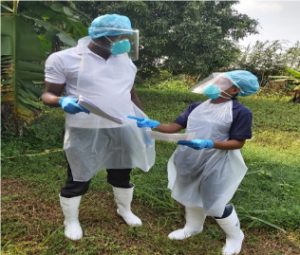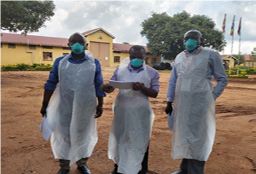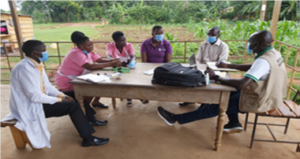 |
Peter Omms OumoBSc. EHS (MUK), MPH (IHSU), Advanced Field Host Site: National Malaria Control DivisionHost Mentor: Dr. Damian Rutazaana, Dr. Daniel Kyabayinze, Dr. Jimmy Opigo |
|||
ABOUT THE FELLOWSP Peter Oumo is a field epidemiologist with a background in environmental health. I hold a Master of Public Health from International Health Sciences University (IHSU). During my tenure as a Public Health Fellow, I have been attached to the National Malaria Control Division (NMCD) of Ministry of Health where I have developed confidence in myself amidst challenges of the lockdown and learnt to work in a dynamic environment. No sooner had I reported to the host site that was the lockdown instituted. We have literally been known as the COVID-19 cohort. Achievements at the Host Site
Fellowship program specific achievements
Co-investigator
HIV Project
Quality improvement project
Scientific WritingArticles in the MOH Epidemiological Bulletin
Newspaper articles
Manuscripts Lead author
Co-author
Conference presentations
Summary of Epidemiological Study:Title: Description of Malaria Deaths in Selected Districts in Uganda January 2020—May 2021Introduction Background:In Uganda, malaria accounts for 30-50% of outpatient visits, 35% of hospital admissions, and 13% of hospital deaths. However, the characteristics of persons who die of malaria in Uganda are not well-described. We investigated the characteristics of malaria deaths in high-malaria-burden districts to inform programming for targeted interventions. Methods:Cases were defined as death of a hospitalized person with a positive microscopy or rapid diagnostic test for malaria from 1 January 2020-30 May 2021. We used District Health Information System 2 malaria death data to identify districts with the highest case rates in Uganda during this period. We selected 8 high-burden districts from various areas of the country (Agago, Apac, Kitgum, Napak, Nebbi, Iganga, Kakumiro, and Kikuube) and visited all Health Centers (HC) III, HC IV, and general hospitals to abstract data on cases at the facilities. We abstracted data on age, sex, health facility name and level, district, diagnosis, date of admission, and date of death. Mortality rates (MR) were computed using deaths (cases) as numerators and district populations as denominators. We analyzed the data by demographic and geographic characteristics. Results: Among 273 cases, 157 (58%) were male; median age was 5 years (IQR: 2-13). The overall MR was 11/100,000. Children <5 years had a higher MR than persons ≥5 years old (25.6 vs 7.1/100,000). Agago district had the highest mortality rate (35/100,000) followed by Nebbi District (20/100,000) and Napak district (18/100,000); all three are in the northern area of the country. Most malaria deaths occurred during June-August. Conclusion: Children <5 years experienced malaria death rates four times higher than older age groups. The highest malaria death rates occurred in northern Ugandan districts. Malaria prevention measures and appropriate clinical management should be heightened amongst children <5 years in these districts. Key lessons learnt during the fellowship
Next StepsWith the skills Peter Oumo has acquired through the fellowship tenure, I hope to further my career in the field of epidemiology through service in an organisation that will provide me with the opportunity to serve and practice my epidemiology and other skills learnt along the fellowship. Pictorial
|
||||
Sign in
Sign in
Recover your password.
A password will be e-mailed to you.



